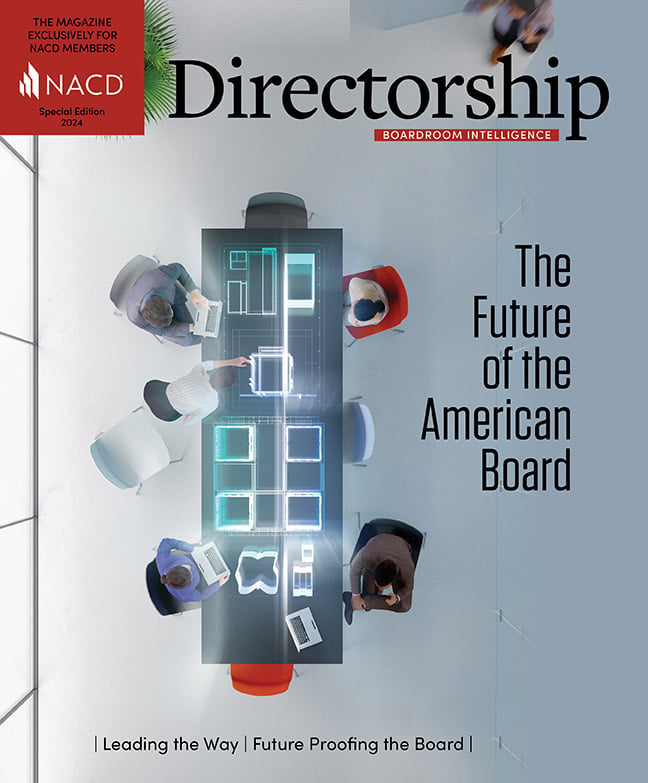
Trending Oversight Topics
Governance Surveys
Center for Inclusive Governance
Article From Our Partner
Is Your Compensation Committee Ready to Expand Its Scope?
01/22/2024
As compensation committees explore expanding their scope of responsibilities beyond traditional executive compensation parameters, they have realized it requires more than changing the committee’s name and updating the charter.
Such tactical changes are an important signal and will overtly represent an expanded involvement in broader human capital areas. However, they should not happen before the committee has fully assessed its readiness to take on the additional responsibilities that come with an expanded remit.
Committee Commitment
The single most important readiness criteria is that the compensation committee leadership and membership be fully committed to change and growth. A majority belief that broader human capital topics—ranging from succession planning and the development of senior leaders to environmental, social, and governance and diversity, equity, and inclusion—are essential to the future of the organization is a required foundation for productive discussions. Further, the committee should have a unified appreciation that these issues cannot be addressed independent of the attraction, retention, and motivational properties of a carefully designed compensation plan.
This kind of visionary inclination on part of the committee is likely driven by directors who have experience that adds value to the conversations. Boards that pursue this expanded remit may want to include such skills in the matrixed profile of future compensation committee members.
Spirit of Partnership and Cooperation
In addition to committee engagement, the success of any talent management initiatives will hinge on support from the CEO and their direct reports. In recent years, stakeholder—including shareholder—expectations for broader human capital management has risen significantly. But for the board to effectively assess or guide in these new areas, there must be a spirit of partnership and cooperation between directors and the C-suite.
No doubt, the bright line between oversight and active management has begun to blur, at times making both sides uncomfortable or unsure. Pushing through this uncertainty and being open to evolving roles will allow boards and management teams to explore new ideas that may ultimately lead to a stronger organization—one that experiences less risk and more growth over the long-term.
Taking the First Step
One way to raise awareness and initiate broader conversations is to incorporate a “human capital update” agenda topic at each committee meeting. This update, which is typically led by the chief human resources officer, can begin to consistently shine a light on key human capital issues. While the topics can vary from meeting to meeting, they often include high-level reports on such matters as turnover, talent acquisition and development, and progress on diversity initiatives. These updates provide a great opportunity to contextualize compensation matters and often springboard into strategic discussions on key organizational imperatives. For example, by examining turnover, committee members can better understand and provide suggestions as to retention strategies and succession planning efforts.
Overcoming Potential Obstacles
Of course, the committee will face challenges in expanding its sphere of influence. One very real obstacle is accommodating the additional time that new areas of attention require. Since the core executive compensation responsibilities are not abating—if anything, they likely have increased—it is important to be as efficient as possible with the committee’s allotted time. One way to achieve this is by including time allowances by topic in the agenda so that routine matters can be dispatched quickly. It can be helpful to structure certain agenda items as “discussion only” with related materials in an appendix as a “pre-read”. This can mitigate the potential for too much presentation and insufficient discussion, which slows meetings down without productive results.
Going Further
As the compensation committee assesses its readiness and begins the exploration of talent and leadership issues in tandem with executive pay plans, additional ideas for furthering progress can be helpful. Documenting the committee’s expectations and goals can provide milestones for achieving a measure of progress. The use of an annual committee calendar with integrated compensation and leadership topics and decisions will add routine and structure to meetings. Access to advisors with experience in guiding the integration of compensation and leadership can be highly valuable. Finally, ongoing, open conversations with the full board about the committee’s expanding purview will provide critical alignment. ■
Pearl Meyer is a NACD strategic content partner, providing directors with critical and timely information, and perspectives. Pearl Meyer is a financial supporter of the NACD.
This article is from the Directorship Special Issue 2024: The Future of the American Board.

Steve Van Putten is a senior managing director with Pearl Meyer and leads the firm’s efforts with respect to thought leadership and intellectual capital development.
NACD Directors SummitTM
